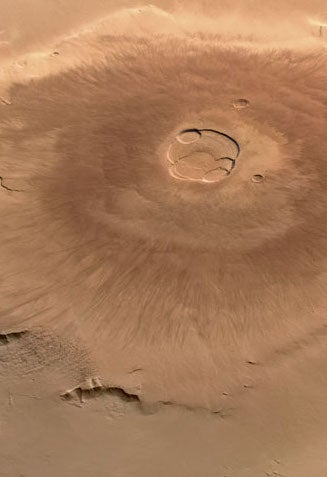By Ellie Moreland
Towering roughly two and a half times the height of Mount Everest, Olympus Mons sits on the equatorial region of the planet Mars.
Image Credit: NASA/ESA (https://science.nasa.gov/olympus-mons-largest-volcano-solar-system)
A massive shield volcano, Olympus Mons was built by the multitude of lava flows that cascaded down its sloped surface over billions of years. The sheer size of Olympus Mons has drawn lots of scientific attention, and debate, that has uncovered many interesting traits about our solar system’s largest volcano.
So how did Olympus Mons form in the first place? Most current research suggests that Olympus Mons is the result of a magma plume under the surface, similar to how the chain of Hawaiian Islands formed on Earth. This plume may have supplied the lava that built up the shield of Olympus Mons, but it was able to grow significantly larger than the Hawiiaan Islands because Mars’ gravity is only about a third of what we experience on Earth. It was also a product of a world without plate tectonics. Unlike the Hawaiian chain, which formed as the pacific plate traversed over the hotspot, the magma plume under the stationary lid that is Mars’ crust, continued to supply lava to the exact same spot over millions of years, building lava flow on top of lava flow.
As we view Olympus Mons from orbital imagery today, its shape is roughly circular with a sharp escarpment at the base of its flanks. An escarpment is where there is a steep cliff, which around Olympus Mons can reach heights of up to ~7 km in the northwestern region. It is the formation of this extremely prominent feature that is subject to recent debate.
Studies such as the 2004 paper led by Patrick McGovern from the Lunar and Planetary Institute used orbital data to show that some of Olympus Mon’s basal scarp was formed via catastrophic mass movement events, or landslides. A 2014 paper led by Dr. Weller from Rice University provided additional evidence that the Olympus Mons basal escarpment formed by common landslide processes in addition to volcanic spreading. Both studies suggest that as the lava flows built up over time, the added gravitational load could cause slope failures and mass movements, creating the escarpments we observe today.
In contrast, a recently published article in Earth and Planetary Science Letters led by Dr. Hildenbrand of Université Paris-Saclay suggests these escarpments formed when lava flowed into liquid water. When molten rock hits ocean water, it quickly solidifies and can form sharp relief features. This means the break in slope observed in the escarpment could represent the location of the ancient shoreline, where the lava flows met the water. In order to have such a steep slope, Hildenbrand and coauthors suggest that an ancient Martian ocean had a water column at least 6 km thick when the volcanic Island originally formed. In support of their theory, they also site the concave profile of Olympus Mons escarpment, a feature commonly observed when high viscosity lava meets the low viscosity water.
Rice expert on volcanic island evolution, Dr. Julia Morgan, has reservations about identifying Olympus Mons as an ancient volcanic island. Morgan suggests that the variable height and morphology of the Olympus Mons escarpment represents “a complex time-varying history of basal scarp formation and destruction during volcano growth and deformation” as opposed to island formation during the time-limited existence of an ocean. Furthermore, Morgan is skeptical about the hypothesized ocean depths from the EPSL article, as “complications of plausible shoreline indicators across the Martian landscape [do not] support the claims made for such great ocean depths”. The escarpments of Olympus Mons could instead be discontinuous benches of lava that form as the volcano spreads outwards during growth, which does not require a shoreline to be present at all.
Even with the unresolved question about the formation of Olympus Mon’s basal escarpment, most researchers can agree that the volcano is a prime target for future in-situ investigations. Hildenbrand and colleagues note the importance of radiometric dating of lava samples from the basal escarpment in their article. Morgan agrees with their point and highlights the potential “insights into the eruptive and depositional settings of the rocks found in this area”. Samples from Olympus Mons could greatly help in constraining the history of volcanism on Mars as well as provide more data to try and resolve the escarpment debate.
Ellie Moreland is a PhD candidate working on Mars mineralogy and water-rock interactions. She is working on an algorithm (MIST- Mineral Identification by SToichiometry- mist.rice.edu) to identify minerals in data from the Mars2020 Perseverance rover PIXL instrument, and works with climate models to simulate lakes on early Mars.

